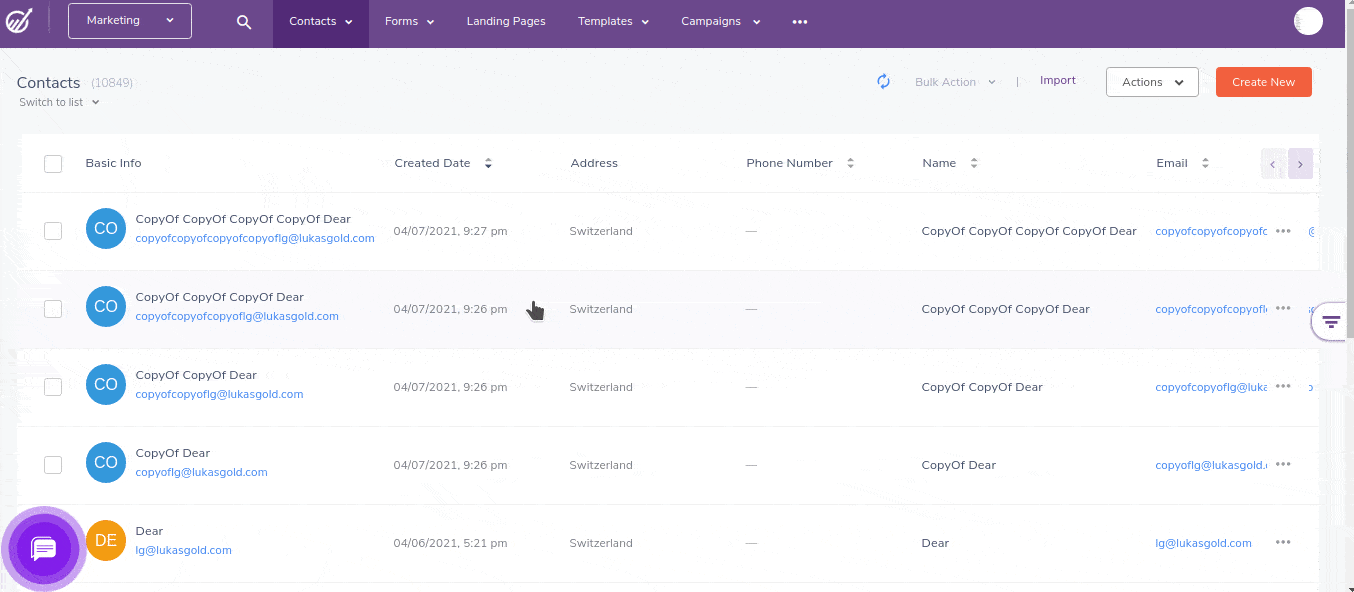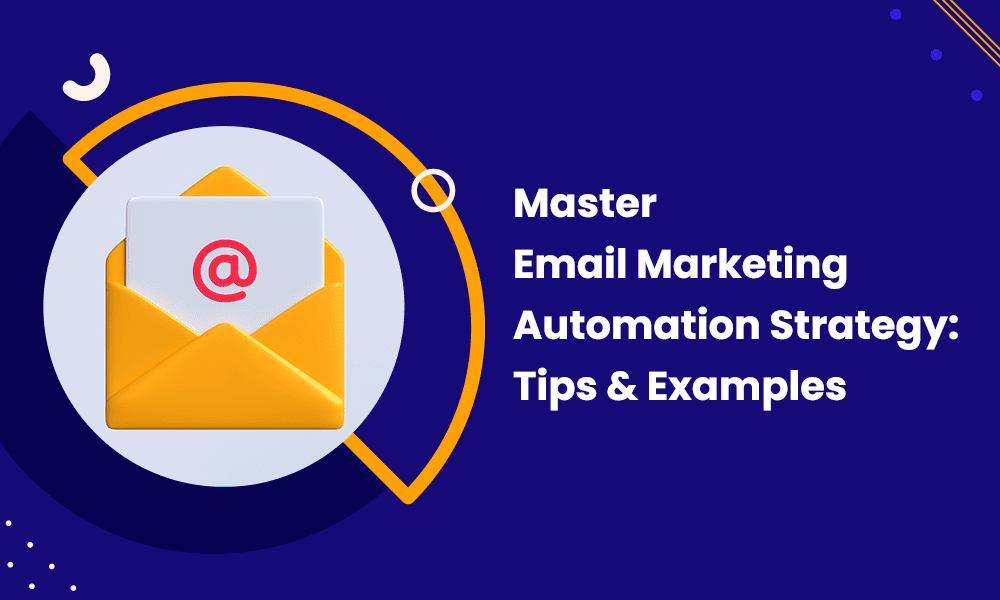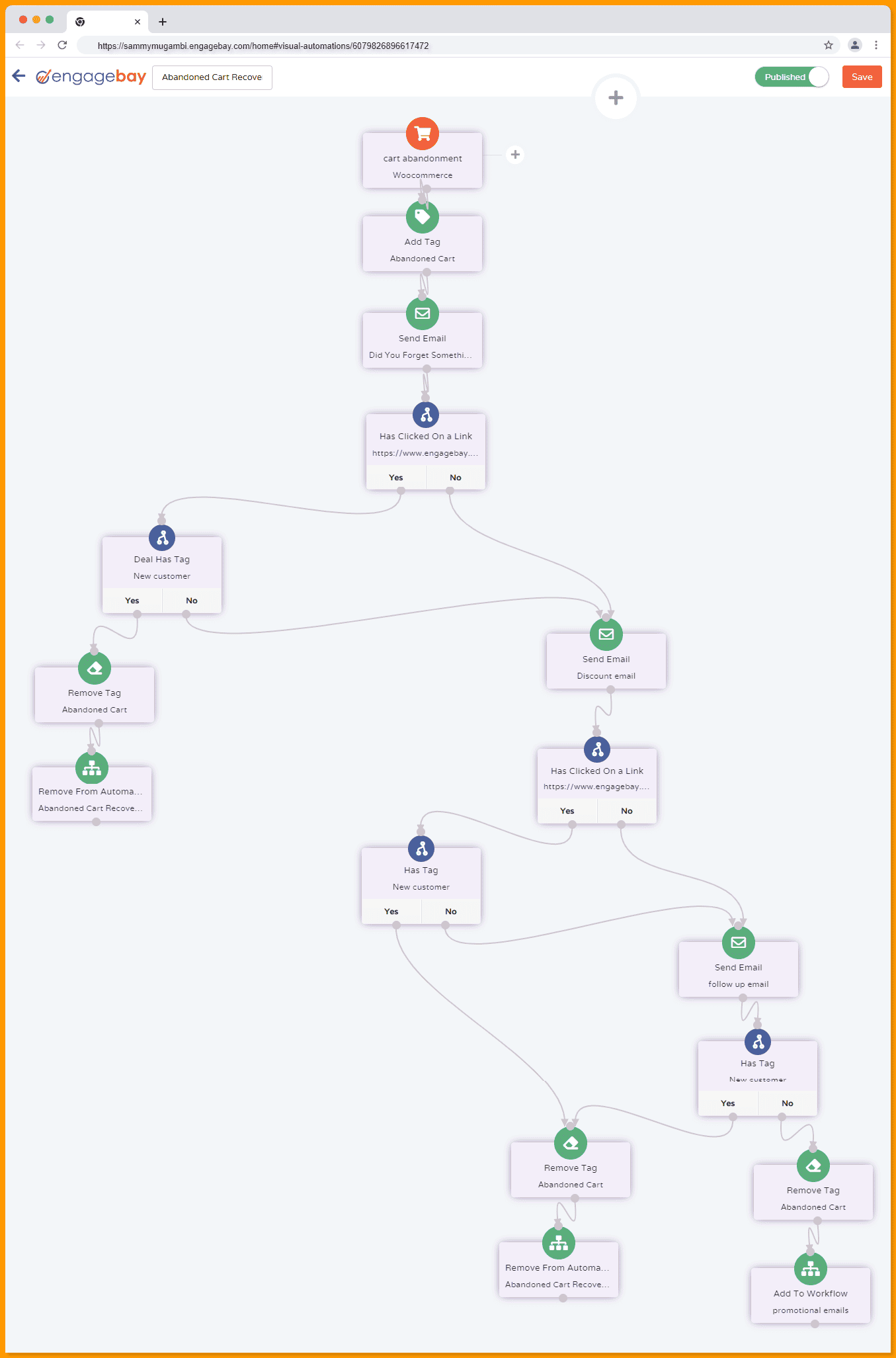Building an opt-in email list from scratch is hard work! Even if your copy’s good, you don’t know if people are reading your emails or if Gmail and gang are shunting them to spam. It might be that they are not displaying correctly, or you’re sending too many at once.
It’s like shooting in the dark and hoping you’ll hit the bulls-eye. With the right email marketing automation strategy, you can hit all your goals and then some. After all, it helps you aim with precision.
In this article, you’ll learn how to build one with the help of examples and pick up some best practices you can use right away.
Let’s get started.
Table of Contents
What Is Email Marketing Automation?
In a nutshell, email marketing automation lets you send emails to your list(s) without actually pressing the send button a million times. You set up triggers or criteria for sending automated emails based on customer activity or scheduled events (webinar, for example), and the software will do the rest.
The best part? Email marketing automation tools learn about customer preferences and optimize when, what kind, and how many emails to send. Now, you can ditch ‘spray and pray’ email campaigns for good.
How Does Email Marketing Automation Work?
Abandoned cart recovery marketing automation flowchart
Email marketing automation sends emails in response to specific customer actions or pre-defined workflows. There are three key elements in an email marketing workflow, as explained below.
1. Trigger
An event, date, or time when an email is to be sent. An event could be email newsletter sign-ups, downloads of lead magnet, filling out a contact form, cart abandonment, etc. Similarly, if you know a customer’s birthday is coming up based on CRM records, you can set up automated birthday emails. You can change the triggers at any time.
2. Email list
You’ll need a list of contacts to send emails to. These contacts could include existing customers or new accounts/leads, based on the type of campaign you’re doing. For example, referral emails, appointment reminders, etc.
3. Message
This is the ‘what’, ‘why’, and ‘how to’ of your offer. The subject line, copy, and CTA should be clear and concise. You can set up one email or an entire sequence based on your marketing goals. For example, a single welcome email versus a complete onboarding sequence introducing your product to customers.
The key is to tie these elements together with a cohesive email marketing automation strategy.
Read also: Email Marketing vs Marketing Automation: A Marketer’s Guide
5 Benefits of Email Marketing Automation
Email marketing automation can increase the reach of your email campaigns and the productivity of your marketing team in a few seconds.
1. Scale campaigns
For most marketing teams, there’s never enough time – between segmenting lists, A/B testing messages, and email seed testing – to pay attention to the actual message. It’s not like you can skip any of these tasks. Email automation takes away a huge chunk of the grunt work involved in building and scheduling email campaigns.
This means your team can better focus on optimizing copy, design, send times, and frequency for maximum deliverability. With the right email marketing automation strategy, you can rapidly build and scale your campaigns.
2. Improve deliverability
Blasting emails to your entire list in one go can cause an avalanche of spam reports. Email service providers cap the number of emails a domain can send each day. If you hit the limit, your email deliverability will be impacted.
Email marketing automation tools analyze the average open rates, CTR, reply rates, unsubscribe rates, and spam reports to identify the best send times and frequency. They also come with built-in email authentication features, helping you beat spam checkers.
3. Deliver personalized content
65% of marketers say personalizing email marketing is a top priority. However, it’s not just about using the reader’s name. Emails that get the best engagement touch upon customer pain points and build on any previous interactions they may have had.
Email marketing automation personalizes messaging based on funnel stage, page views, purchase history, ICPs, and other data, driving engagement and sales. It syncs with CRM, Google Analytics, and other tools based on your email marketing automation strategies to do this.
4. Reduce costs
If you’re a startup, you’ll find email marketing automation much cheaper than hiring a full-time employee at about $76,000 a year. EngageBay offers free emails along with landing pages, web forms, and templates.
This means cost or team size is no longer a barrier when it comes to running email campaigns for different target audiences or customer groups- provided you use the right email marketing automation strategy, which we will get to in the next section.
5. Increase revenues
Email marketing automation can be used to guide customers through their journey through targeted offers at key decision points. It can help overcome nagging problems like cart abandonment and drive cross-sell and up-sell opportunities.
The key is segmentation using engagement data and analytics.
Read also: eCommerce Welcome Emails: Dazzle, Delight, Convert [Examples & Templates]
Develop an Email Marketing Automation Strategy That Works for You
Before you buy an email marketing tool, you need a plan for where and how to use it. In this section, we’ll look at the basics of creating your very own email marketing automation strategy.
1. Identify goals and KPI
Do you want to nurture high-value prospects, recover abandoned carts, or upsell to existing customers using email automation? Breaking down your goals for the campaign into specific outcomes helps you identify what metrics and KPIs to track.
For example, if your goal is to increase sales, the metrics to focus on could be conversion rate or average order value. The pertinent KPIs would be open rate to revenue, sales per click, etc. Benchmark your KPIs against the industry average to assess your actual performance.
2. Identify the target audience
Next, it’s time to define who to target. Based on your funnel stages, you can include active and inactive contacts or leads. For example, first-time visitors versus cart abandons. You can segment them further based on demographics, purchase history, and email engagement metrics such as opens, CTR, etc.
This should help you send specific offers for different segments.
3. Personalized offer and CTA
Ensure that the message and CTA are closely aligned with the main offer of the campaign. It must be clear and concise so that readers know exactly what you want them to do. To do this, use the segmentation and analytics data you’ve collected to map your customer journeys.
For example, differentiate discounts as ‘first-timer’ discounts (awareness stage), time-based discounts (consideration stage), and upgrade to VIP (post-purchase stage).
4. Develop effective landing pages
OK, so your CTA and copy worked. The subscriber clicked on your email. What’s next? The landing page you send them to must provide continuity and build on the offer with additional pricing and T&C details. For this to happen, it should have the same design and branding as the email.
If you’re using an email sequence, you can have more than one landing page that talks about the unique selling points individually and, finally, puts out the offer. It’s not an easy task by any means.
This is where landing page builders come in handy. EngageBay lets you not only create landing pages with multiple offers but also A/B test them.
5. A/B test and tracking
The typical email has multiple elements – subject line, body copy, and CTA. Each element can impact the performance of your campaign. For example, a subject line with financial terms can get sent to spam. To avoid this, test some variations with and without those words or phrases.
Compare the results and optimize. Also, you need to ensure that people who don’t fit your ICPs are not shown every offer. For this, UTM codes and web analytics can be used as a gatekeeper.
6. Reports and analytics

Email marketing campaigns can fluctuate over time in terms of performance. If you see low open rates or CTR, you can use reporting tools to trace the root cause back to your email elements, tracking rules, or authentication protocols.
Real-time reporting is critical as you try out new visual and copy elements to keep users engaged across the buyer journey.
Read also: Make No Mistake: Email Marketing Automation Best Practices
Types and Examples of Email Marketing Automation
Now that you know what goes into an email marketing automation strategy, here are some key use cases for inspiration.
1. Welcome emails
As soon as a customer makes a purchase or signs up to your list, send them a triggered welcome email. Believe it or not, 74% of customers expect to get one from you. The fact is that welcome emails are more likely to be opened than other emails, and their potential for revenue generation is substantial.
The welcome email should introduce your team or the values and vision behind the things you do on a day-to-day basis. Better still, you can create a 3-part welcome email sequence to do this in bite-sized bits.
Here’s a sample welcome email flow you can try out.
Email 1
Start with a quick hello, introduce the brand, share links to FAQs, blog articles, etc. Don’t forget to add a ‘Contact Us’ button for them to reply.
Email 2
Give them a ‘behind-the-scenes’ peek at your production process and tell them what makes it different. Don’t segue into an offer yet.
Email 3
Close the email sequence with a quick recap of your products, and unique selling points and slip in an introductory 10% off discount.
2. Abandoned cart emails
Customers may have second thoughts about buying a product online if they aren’t sure about shipping costs or if the checkout page is too complicated. Thankfully, you can set up an automated email flow to recover abandoned sales.
Abandoned cart emails remind customers about the items in their cart, and inform them when you’ve introduced a new product in the same or related category.
Use UTM codes and tools like Google Analytics to track user activity and retarget only users with abandoned carts. EngageBay offers advanced cart recovery workflows you can deploy in minutes.
3. Onboarding emails
Automated onboarding email flows continue engaging where your welcome email left off. You can use them to walk customers through product categories, features, and user guides. This is especially critical for B2B marketing automation, subscription-based businesses, and loyalty programs, where members need to track their orders, points (rewards), upgrades, etc.
4. Upsell emails
Want to convert free trials into paid memberships? Automated ‘drip’ campaigns can be the perfect way to show users how they can get more value out of it. An upgrade offer at the end of an onboarding flow isn’t half as salesy as a year-end discount.
However, you may need to try a few different offers to see what works. EngageBay’s A/B testing lets you churn out compelling upsell offers consistently.
5. Birthday emails
Who doesn’t like birthday specials? A promo code or coupon and a personalized greeting can make you a customer for life. You must keep their time zone in mind when setting up the automation though. You don’t want the email to arrive too late in the day or the next morning!
EngageBay’s email broadcast tool makes sure your messages arrive on time – always.
6. Re-engagement emails
If existing customers go cold on you after a while, you can use automated ‘come back’ flows. All you need to do is segment inactive subscribers who haven’t opened or clicked in the last 60 days, and the email tool will do the rest.
You can send two different offers based on whether or not they have purchased in the past. No engagement is a clear sign that they’ve moved on, and it’s best you do, too. In other words, sunset them.
7. Renewal reminders
With automated renewal reminders, you avoid losing out on revenue while customers can get on with their lives. Set the email trigger for at least 14 days before the renewal date.
Better yet, to be on the safe side, set up a three-email sequence to run every few days leading up to D-day.
8. Order confirmation and shipping updates
If you’re strategic with these emails, you can use them to generate sales. For example, show dynamic product recommendations with an ‘order now’ button – placed prominently just above the footer.
Email marketing tools like EngageBay allow you to add custom email elements.
Read also: Email Automation Basics, Tips, and Examples
Best Practices for Implementing Email Marketing Automation
Email marketing automation can deliver scale and accuracy. However, don’t overlook the following factors.
1. Use a simple opt-in form
Make sure you include no more than 3-4 fields on your opt-in form. These fields should only ask for information you can use for personalization. If you ask for too many details, you might annoy users, and they might back out.
2. Set performance benchmarks
Use the historical performance data to benchmark performance. It will help you identify patterns and understand the reasons for improvements or declines. Based on these insights, you can predict if a campaign will meet KPIs and make changes accordingly.
EngageBay offers custom reports and analytics where you can compare historical data with current performance and optimize your sales strategy.
3. Set up a performance monitoring workflow
Most email marketing automation tools can track multiple campaigns and compile reports automatically. However, you need to define the right reporting cadence – be it weekly, monthly, or campaign-to-campaign. Secondly, select the right KPIs so that the data is not overwhelming.
The KPIs you choose must directly impact business performance. This helps you provide timely strategic input to management and get their buy-in on process improvement. However, if you use multiple marketing tools, consider integrating them into a seamless workflow.
4. Strategic discounts through segmentation
Don’t give discounts freely to everybody on your list- the returns won’t be worth it. Instead, segment the list based on engagement and purchase history into three categories – let’s call them engaged, somewhat engaged, and disengaged.
Engaged people who have bought from you before or at least opened your emails should get the biggest discounts. The other two categories need more nurturing before you can offer them any discounts.
5. Automate one campaign at a time
It can be tempting to go all-in on automation. After all, you want to get the most out of your investment. However, start slow and scale up gradually. This can help identify potential bottlenecks and shorten the learning curve for your team.
Imagine having to recall emails or apologizing to customers for freak errors after the emails have gone out. This also has implications for email deliverability and sender reputation. In any case, use email seed testing to iron out any display, copy, or authentication kinks before sending emails.
6. Don’t set too many automation triggers
If you use too many triggers, you risk sending multiple emails daily. The result: a glut of unsubscribes and bad reviews. Make sure you double-check the send frequency when setting up automation flows. This is especially critical if you run multiple email campaigns each day.
The key is to stick to 5 or 6 touch points, from first contact to post-purchase. Add automation triggers only after you’ve mapped the customer journey.
7. Keep customer preferences front and center
Remember to allow customers to opt-out or control the number of emails they receive. That means the update preferences center should be visible across devices or email clients and let subscribers choose what emails they want to receive.
Analyze the data so you can identify and adjust email send frequency and content accordingly.
Read also: Marketing Automation 101 For The Beginner [With Examples]
Conclusion
Most brands can do a lot more with email marketing automation than they currently are. The truth is that every business is different, and a cookie-cutter approach doesn’t work. Now that you’ve learned how to build automation into your email workflow, why not check out EngageBay’s email templates and A/B testing features?
Many of our customers have been using it to crush their marketing goals, and so can you.
Learn more about our 2023 Holiday discount!


